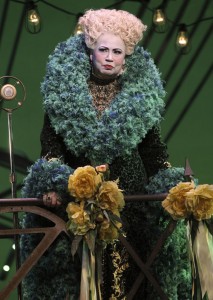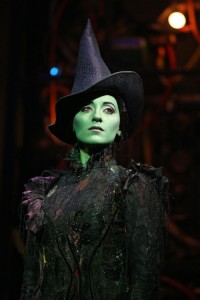Tuesday night at the music hall in Fair Park, the noise from the balcony was deafening. Patrons at the orchestra level were craning their necks in wonder at the cafeteria cacophony from above. The energy threatened to flow over and fall on us but was distracted by the timely overture at which squeals reserved for teen rock bands rang out. But this was not rock and roll. This was Wicked, the back-story of the witches that make Judy Garland’s Kansas vacation so memorable.
Dorothy doesn’t appear in this musical mega-hit; it’s not her show. This is the sympathetic revision of the misunderstood Misses of Oz, which bridges Gregory Maguire’s Life and Times of the Wicked Witch of the West with the MGM Monolith Movie. In this iteration, determining your identity is the battle. It’s all about how perception rules popularity and popularity rules politics whether in school or the Emerald City, which explains why it’s not just high schoolers hooting but their parents as well. Whatever you say about it, it better be positive because they take it personally.

Beginning at the end is so common now as to be expected. Glinda, the Good, floats in a clock pendulum bubble to reassure the populace that yes, the Wicked Witch of the West is dead. The audience familiar with the movie will appreciate this moment to get their bearings. In fact, the writers carefully place points throughout that elicit aha’s of familiarity in this otherwise totally different story. From here we flash back to Shiz University to discover that Glinda was classmates with the girl born green, Elphaba. From the get go, Elphaba is different and not just because of the color of her skin. She loses control and reveals that she can perform magic that terrifies her classmates. On the other end of the spectrum is the sparkling and popular Gahlinda making for the perfect odd coupling as they are assigned to be roommates. School, the seething soup of identity, is the best place to explore the same themes that Harry Potter road like a broom to the bank. Chiefly, our powerful desire to discover that through no effort of our own, we’re special and that our differences mean we’re powerful. But no power can control love as the girls green and not find out when Fiyero, the über-popular boy-hunk transfers to the school. Trouble brews. Which witch will he woo?
The story, compelling as it is, would not account for the show’s unrivaled success. The team of Stephen Scwartz (music and lyrics) and Winnie Holzman (book) combine Broadway, movies, and television know-how. That may account for the feeling occasionally of seeing this before. They know what works and aren’t afraid to sail those waters. Joe Mantello’s direction combined with Wayne Cilento’s musical staging adds their Tony’s to the experience tally. But none of them won for this show. It was the designers for set and costume who swooped and swiped the statues, deservedly so. Eugene Lee’s clockwork set does tricks and tocks. It is flexible and transporting. But it is Susan Hilferty’s costume design that declares design dominance. No seam is left unembellished in the ensemble. It is as if to make up for having to design inside a recognizable image of Witches East and West, her creativity exploded onto everyone else. Add to this projections by Elaine J. McCarthy and special effects, and you’ve got a magical masterpiece indeed.

The most magical moment came not from song, set or effects, though. At the dance, future wicked Elphaba, after arriving wearing a ridiculous hat Gahlinda had tricked her into wearing, tries to defiantly dance away the demons despite the deafening silence. Gahlinda has a change of heart toward her green skinned roommate and dares détente with a silent dance of her own, taking Elphabas movements and making them gently graceful. We see the bravery of Gahlinda risking her popularity on this silly dance and of Elphaba to trust that Gahlinda is acting out of a desire for peace. This reconciliation plays out in gesture and silence as a dance between wronger and wronged. As Gahlinda turns awkwardness to beauty, hostility becomes camaraderie. The effect on the crowd is total, and they join in.
This only works if the performers can pull it off, do they. Donna Vivino brings a defensive flair to her Elphaba. Her great number is “Defying Gravity,” in which she embraces her path with furious ecstasy. We feel the plight of the stung and unsung through her. More surprising is the empathy we feel for the good Gahlinda played by Chandra Lee Schwartz. Her great number is “Popular,” in which she manages to make it seem as if the potential for sharing the secrets of popularity overcomes her, rather than some dignitary deigning to bestow them from a privileged position. It is not easy getting sympathy when you are the popular one, but somehow she does. Together black and white form a friendship you feel. The other standout in the cast is Jayne Houdyshell as Madame Morrible. As the headmistress and later the Wizard’s propaganda producer, she is feminine in the manner of a Disney step-mother. Houdyshell is entertaining as she is terrifying, and we spare no pity for her.
The only droop to the delight is the second act scene between the pre-wicked sister witches of East and West. In short order the musical tries to explain too much of the back story and we get a glimpse of what the finale to “LOST” could have been: clunky. The light hand and winking eye that is prevalent everywhere else in the show disappears for one scene as they exchange their watercolors for crayons. Word to the world of musical makers: if it feels like work explaining, it feels the same watching. It’s only worth mentioning because the rest of this production will have you singing, “We’re off to see the Wicked, the wonderful Wicked…” Because.
Photo: (From left): Chandra Lee Schwartz and Donna Vivino (Joan Marcus for Wicked)






